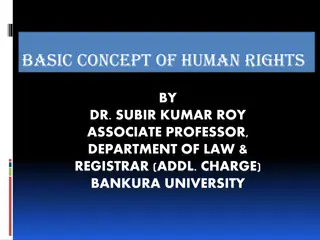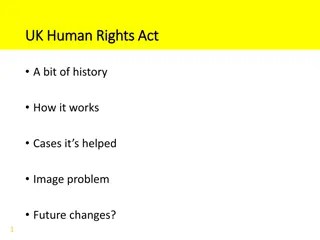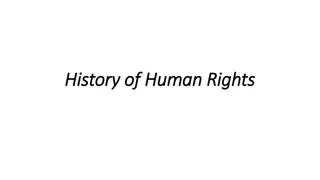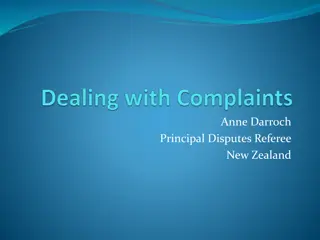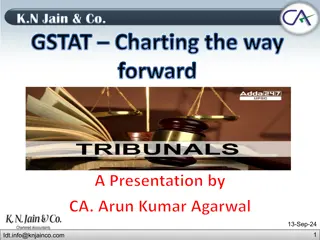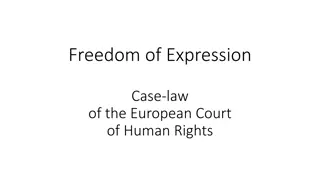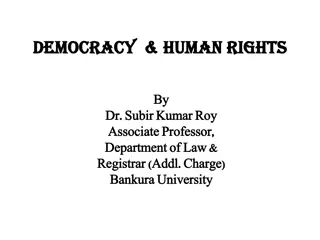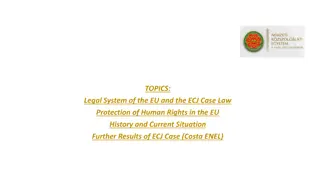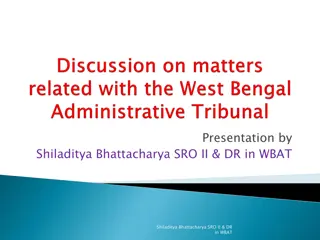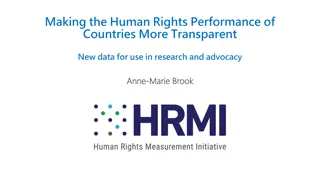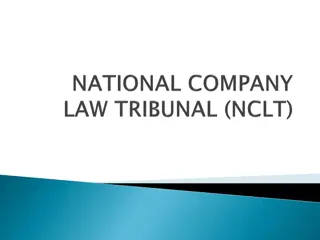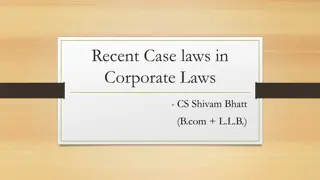Insights into Implementing Human Rights Code: Tribunal's Perspective
Providing valuable insights from the Human Rights Tribunal of Ontario's Associate Chair, David A. Wright, this presentation delves into key principles of the dispute resolution model, challenges faced, adaptations made, and future considerations. It highlights statistics, social areas, grounds for applications, decision types, and mediations, offering a comprehensive view of the tribunal's operations and impact.
Download Presentation

Please find below an Image/Link to download the presentation.
The content on the website is provided AS IS for your information and personal use only. It may not be sold, licensed, or shared on other websites without obtaining consent from the author. Download presentation by click this link. If you encounter any issues during the download, it is possible that the publisher has removed the file from their server.
E N D
Presentation Transcript
Implementing the new Human Rights Code: The Tribunal s Perspective David A. Wright Associate Chair, Human Rights Tribunal of Ontario Social Justice Tribunals Ontario
Outline of Presentation Some Numbers Key Principles of the Dispute Resolution Model Challenges and Adaptations Questions/Challenges for the Future
S. 34 Cases Resolved 4000 3541 3500 3363 3166 3000 2737 2500 1736 2000 1500 1558 1429 1000 2717 1937 500 18 0 2008-092009-102010-11 2011-12 2012-13 (First Half) Applications Filed Applications Closed
Social Areas % of 2011-12 Applications Naming Social Area 6%1.20% 1% Employment Goods, Services, Facilities Accommodation 20% Membership in a Vocational Association Contracts 70%
Grounds % of Applications 2011-12 naming ground 60% 52% 50% 40% 30% 24% 20% 20% 10%12%14%14% 14% 4%6%10% 4%6% 10% 4% 1% 0%
Decisions: S. 34 Applications Type of Decision Final decision on the merits Discrimination found Discrimination not found Dismissal on a preliminary basis* Deferrals Withdrawals** Other procedural issues Reconsideration Breach of settlement decision TOTAL DECISIONS 2011-2012 2010-2011 2009-2010 95 40 55 786 229 3 355 140 12 1,620 104 41 63 562 233 38 570 103 7 1,617 75 29 46 301 147 212 931 66 8 1,740 *This includes cases dismissed under the summary hearing procedure **The HRTO no longer prepares a decision for each withdrawal, and most withdrawals are now confirmed by letter.
Mediations 700 617 600 500 426 387 341 400 332 319 252 249 300 Mediations Held # Settled 212 209 197 162 200 100 0
Representation at Mediation: Applicants, 2011-12 % 26.52 Lawyer Paralegal Legal Support Centre Other Self-represented 54.75 3.98 11.15 3.61
Representation at Mediation: Respondents, 2011-12 % 14.39 1.59 1.04 Lawyer Paralegal Other Self-represented 82.98
Key Features of the Dispute Resolution Model
Applications and Responses Forms are detailed, all facts and a theory of the case are required Tribunal screens Applications and Responses and delivers them Full response on the merits must be filed if the application is delivered and a response is required except in certain limited circumstances
Preliminary Issues No entitlement to have preliminary issues decided in advance of the hearing or mediation Issues other than jurisdiction that may result in dismissal of the application require oral submissions Tribunal frequently raises issues on its own initiative
Initial Screening Tribunal screens for completeness, jurisdiction, deferral Dismissal for jurisdiction may occur following letter to and written submissions from the applicant only Post 2010, Tribunal may also direct summary hearings, 45.1 hearings without requiring response
Mediation Voluntary agreed to in application and response and Tribunal may make calls to encourage mediation Conducted by Tribunal members Evaluative approach Tribunal does not approve or track settlements
Hearings Scheduled for up to three initial days Pre-hearing preparation is key detailed witness statements and documents to be relied upon must be filed 45 days in advance
Challenges and Adaptations
Social Justice Tribunals Ontario As of March 2011, HRTO part of SJTO Includes Landlord Tenant Board, Social Benefits Tribunal, Child and Family Services Review Board, Ontario Special Education Tribunals Under Adjudicative Tribunals Accountability, Governance and Appointments Act, common Exec Chair, accountability documents, etc.
Social Justice Tribunals Ontario Goal of SJTO transformation is to redefine or redesign previously distinct individual tribunals into a single, integrated administrative justice organization, with recognizable component parts based, at least in part, on the original tribunals.
Social Justice Tribunals Ontario \Common general rules, strategic cross- appointments, enhancement of adjudicator expertise through training will be among the first impacts on adjudication
Summary Hearings The concern: no middle ground between dismissal for lack of jurisdiction and full oral hearing Pre-hearing requirements disproportionate to the issues in some cases Both applicants and respondents on Practice Advisory Ctte raised concerns
Summary Hearings July 2010 Rule 19A introduced: 19A.1 The Tribunal may hold a summary hearing, on its own initiative or at the request of a party, on the question of whether an Application should be dismissed in whole or in part on the basis that there is no reasonable prospect that the Application or part of the Application will succeed.
Summary Hearings Can be on the Tribunal s own initiative or respondent request If respondent s request is rejected, no reasons Heard by half-day teleconference in which the applicant goes first.
Summary Hearings Dabic v. Windsor Police Service, 2010 HRTO 1994: In some cases, the issue at the summary hearing may be whether, assuming all the allegations in the application to be true, it has a reasonable prospect of success. In these cases, the focus will generally be on the legal analysis and whether what the applicant alleges may be reasonably considered to amount to a Code violation.
Summary Hearings In other cases, the focus of the summary hearing may be on whether there is a reasonable prospect that the applicant can prove, on a balance of probabilities, that his or her Code rights were violated. Often, such cases will deal with whether the applicant can show a link between an event and the grounds upon which he or she makes the claim. The issue will be whether there is a reasonable prospect that evidence the applicant has or that is reasonably available to him or her can show a link between the event and the alleged prohibited ground.
Hearings Active approach identification and narrowing of issues, active questioning of parties balance can be difficult with a large percentage of self-represented applicants and respondents Different cases call for different approaches balance of predictability, flexibility, individuality of adjudicators
Pellerin Pellerinv. CSDCCS, 2011 HRTO 1777 Reasonable prospect of success test extended to be used in appropriate cases during hearings Maybe be considered after hearing some, but not all evidence Move away from concept of prima facie case
Mediation Standard length for s. 34 Applications changed from full day to half day in 2010 Little to no impact on settlement rate: approximately 60% on the day of mediation 1633 mediations held in fiscal 2011-12; 62% settled
Mediation-Adjudication Rule 15A added and standard agreement developed to formalize mediation- adjudication Frequently offered by the tribunal and requested by parties High success rate
Litigation Guardians No explicit power to appoint a litigation guardian in SPPA or Code Use of s. 34(5) for substitute decision- making: Kacan v. OPSEU, 2010 HRTO 795 Common law power to appoint litigation guardian: Yuill v. CUPE, 2011 HRTO 126
Vexatious Litigants Drenic v. Governing Council of the Salvation Army, 2010 HRTO 1667 Applicant had filed 11 applications all dismissed, 4 no shows, used inappropriate language Power to control process and prevent abuse of process allows for declaration requiring permission to commence apps
No Shows Burden on respondent and tribunal when applicant fails to appear Instituted practice of dismissing applications as abandoned if applicant fails to file documents after a reminder CAD Lukusa v. Toronto Police Service, 2012 HRTO 2054
Questions/Challenges for the Future
Future Questions/Challenges Detailed forms balance of benefits/drawbacks for access to justice Non-complying respondents after decision no breach of order power in Code Ensuring implementation of remedies for future compliance
Future Questions/Challenges Hearings continuing to strike appropriate balance between flexibility, predictability and consistency Maintaining accessibility of process despite sometimes complex human rights concepts Continuing to resolve disputes in a timely way in the face of budget constraints
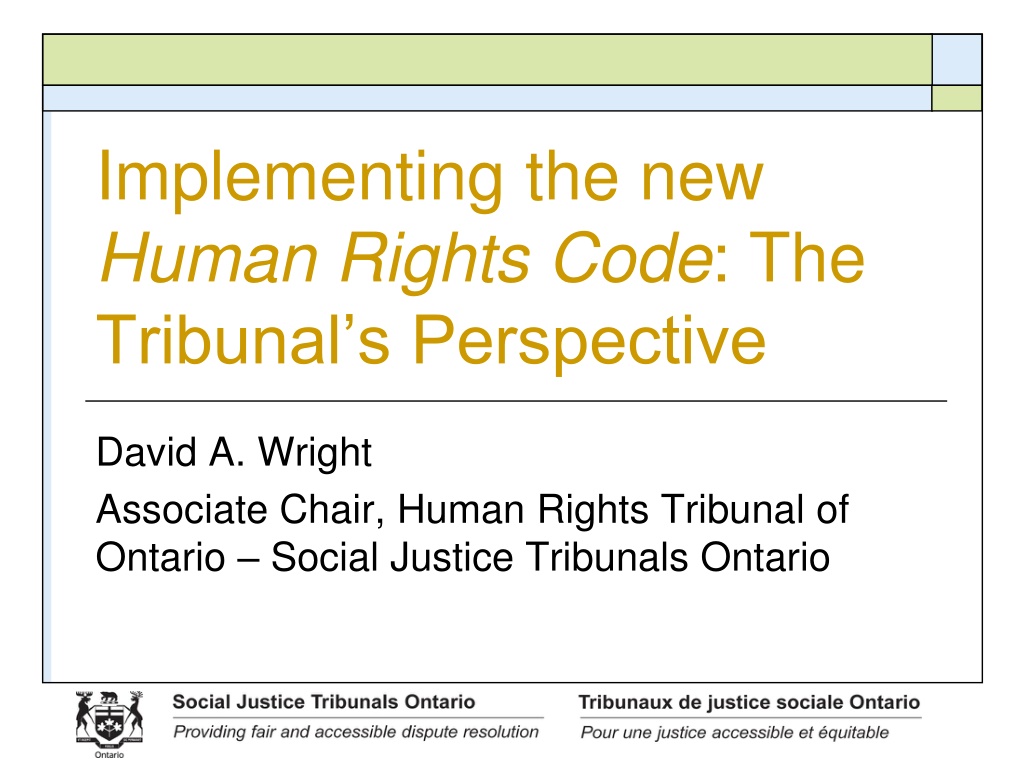
 undefined
undefined









